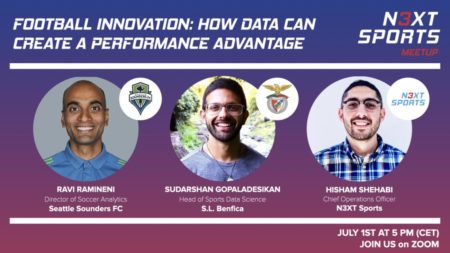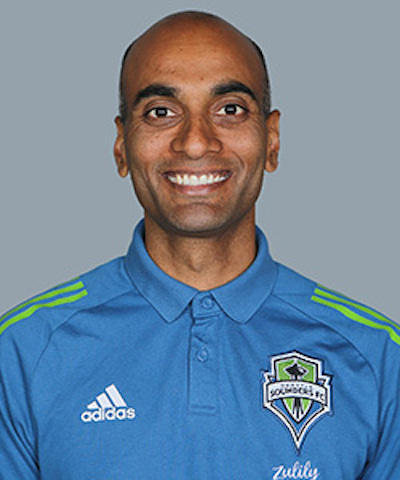
On July 1st, for our weekly online Meetup entitled Football Innovation: How Data Can Create a Performance Advantage, we had the opportunity to hear from two data experts, Sudarshan Gopaladesikan, Head of Sports Data Science at S.L. Benfica, and Ravi Ramineni, Director of Soccer Analytics at Seattle Sounders who shared their insights about how data can create a performance advantage.
With the rising importance of this topic, and the relative lack of knowledge and understanding of it within football and the wider sports industry, their insights are priceless for those in sports performance but also the business side of things. Read on to find out more.
Setting up the data infrastructure
If we look back 10 years ago, many sports organizations did not have a proper data infrastructure in place. When he first started out at the Sounders in 2013, Ravi encountered a business culture that used excel spreadsheets to enter all the data they gathered from the different tech devices the team was using.
Fast-forward to 2020, and it is now common practice for a football organization to have its own performance data analytics department in order to gather and analyze data in order to make better decisions, from players’ performance to scouting new players.
The first step to take in implementing data projects at sports organizations, with a lens to the performance side of the business, is to build a sport science platform that ingests and hosts all the sport science data in a common database, which can support reporting and visualization.
¨Once you have a data foundation, you can gather and analyze the data in a more agile way and that is key when it comes to decision making.¨

By having a data foundation in place, one can give much quicker answers to the coaches, give more detail, and act more proactively.
¨You’ll always have a very solid foundation if you have a proper data model, which will help you organize the data coming from different sources and provide quicker answers to the coaches.¨ – Sudarshan Gopaladesikan
Educating coaches on data analysis
Data is not a foreign concept to coaches as they have been using data for many years. It’s just the format and the form in which they interact with it that has now changed. Part of the data literacy journey for a coach when they’re educating themselves on how to use data properly is to separate the bias from what the numbers are saying and having a proper understanding. On some occasions, coaches use the data to validate their existing theories and assumptions rather than test them further and see if there are any new insights to gain.
It’s not just about gathering and analyzing the data but also presenting the data in the same way that coaches think about their game.
¨We break the data set down into interpretable pieces in the same way that the coach will think as they already have this logical framework in their mind, and we need to have the data presented in a very similar fashion.¨

Technology has played a crucial role in increasing the amount of data and finding a quicker way to validate it. The GPS devices and heart rate devices have gotten more reliable over the years. Sudarshan shared with us how now they are able to get raw data from those devices and how that has become a big plus.
¨One technology that I think can have a big impact on football is Augmented Reality, where you can blend the data from a tracking system and use that to be able to see the perspective of the players on the field.¨ – Ravi Ramineni
Data strategy data support from the league and federation
During the session, we heard how the relationship between clubs, leagues and federations can be very different. On one hand, we have the Bundesliga that works very closely with the German Federation, to make sure that all the teams in the competition have tracking data available to them. Another example is the MLS and how its teams have a very close relationship not only with the US federation but also with other national federations where their players play.
¨Two weeks prior to an international break, the US Soccer federation asks us information about our players, and the same way around, they send us the information form our players right after their training camp.¨ – Ravi Ramineni
On the other hand, we have the example that Sudarshan shared with us and how there is no collaboration yet between the clubs and the Portuguese league on data sharing.
¨I think there is a great opportunity for the league, the federation and the clubs to collaborate together and create a very continuous picture of the athlete by sharing tracking data among all the parties¨ – Sudarshan Gopaladesikan
Using data for scouting purposes
Some time ago, the way teams scouted new players was through watching video and looking at the players’ summary stats. Based on the data collected and analyzed, now football organizations can build their team based on certain qualities.
Now, over the years the way football teams scout their players is completely different.
¨Now we analyze way more deeply than before, based on the position we need, we discuss what type of profile player we need, and looking at data we can choose the right player based on data performance and player characteristics.¨ – Ravi Ramineni
In order for data science to work well, it’s key to have a communication collaboration between a person from the football side, a person from the data science side, and the decision-maker.
Get in touch with our teammate Javier at javier@n3xtsports.com to find out more about some of our turnkey digital transformation projects, including a digital readiness assessment that can set you on your path.
If you would like to read about other online Meetups, you can find all of them here. If you were not able to make it to our online session, you can watch it here, also we would like to invite you to subscribe to our newsletter, and follow us on Linkedin, Twitter, and Facebook to stay up to date with any N3XT Sports news.


